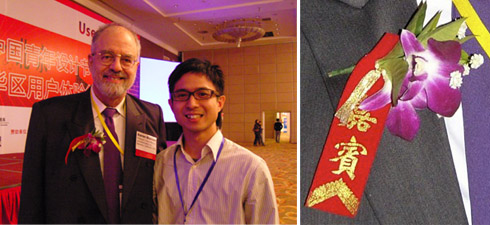Aaron Marcus at User Friendly Conference, Beijing
Aaron Marcus is the founder, President and Principal Designer/Analyst of Aaron Marcus and Associates, Inc. (AM+A). He is well-respected in the Human-Computer Interaction (HCI) field and has been working in this field for more than 30 years. In the Nov/Dec 2007 issue of ACM/SIGCHI’s Interactions magazine, in his “Fast Forward” column titled “The Sun Rises in the East”, he stated that professional development in user-centered software practices in Asia is expanding rapidly, and the level and quality are rising quickly [1].
This year, the User Friendly conference was held in Beijing from Nov 23 to 25. The number of participants of User Friendly conferences increased from 50 to more than 700 participants in just four years! This is an evident sign of the field’s rapid expansion and confirms Aaron’s observation in his column.
I met Aaron Marcus at the User Friendly conference in Beijing, where we posed for a photo. He was curious about the “flower pin” on his suit and asked me the meaning of the Chinese word (Guest) printed on the red ribbon.
Aaron gave a keynote at the conference. His workshop titled “Cross-Cultural User Experience Design for Mobile User Interfaces” covered one of his favourite research topics: the impact of cultural differences on user interface design. He introduced the five dimensions of culture identified by the cultural anthropologist Geert Hofstede (more details can be found in his book “Cultures and Organization: Software of the Mind” and website). Based on Hofstede’s framework, Aaron and his colleagues studied corporate websites in different countries and identified patterns of how the cultural dimensions affect the uses of metaphors, mental models, navigation, interaction, and appearance in the Web user interfaces. He mentioned that the common approach to software localization is limited to accommodating local language and data display formats such as date, time, and currency formats. However, localization is far beyond translation and needs to consider deeper cultural issues. Aaron also showed some innovative mobile user-interface design and explained how they addressed the cultural needs.
Cross-cultural user experience design is gaining more attention as many western software companies are swarming into potential markets like China and India. In the beginning of the workshop, Aaron showed us a 2005 article in Fortune magazine titled “Bill Gates as Anthropologist”. The article cited Microsoft’s Bill Gates as promoting anthropological study of its products. I think this may be an indicator global software companies have realized that recognizing the cultural differences is important to their businesses. Lada Gorlenko of IBM predicts we will see a significant part of UX design being offshored and carrying out by local professionals [2]. Maybe this is happening now. Many global companies such as Microsoft, Google, IBM, Autodesk have already set up local design teams in China.
References:
- Marcus, A. “The Sun Rises in the East,” Interactions, ACM Publisher, Vol. 14, Issue 6, November/December 2007, pp.52-53.
- Gorlenko, L. “Offshoring usability: The moment of truth: how much does culture matter to you?” Interactions, ACM Publisher, Vol 13, Issue 2, March/April 2006, pp. 29-31.
